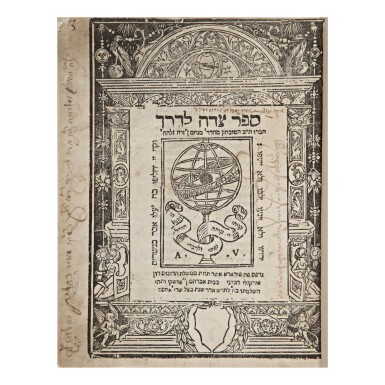
SEFER TSEDAH LA-DEREKH (HALAKHIC COMPENDIUM), RABBI MENAHEM IBN ZERAH, FERRARA: ABRAHAM IBN USQUE, 1554
Auction Closed
November 20, 08:47 PM GMT
Estimate
7,000 - 10,000 USD
Lot Details
Description
SEFER TSEDAH LA-DEREKH (HALAKHIC COMPENDIUM), RABBI MENAHEM IBN ZERAH, FERRARA: ABRAHAM IBN USQUE, 1554
300 folios (7 5/8 x 5 7/8 in.; 193 x 148 mm) (collation: i-iii4, iv2, i-viii4, x2, xi4, xi4, xii-lxxii4) (foliation: [1-14], 1-32, [1-3], 38-75, [1-213]) on paper; modern foliation in pencil in Arabic numerals in lower-outer corner of recto (cited). Title within woodcut architectural frame with printer’s device in center; device repeated on f. 300r; woodcut initial word panel on f. 15r; scattered marginalia in pen toward rear. Slight scattered staining; dampstaining; individual words and phrases expurgated intermittently throughout; ff. 2-4, 7 repaired in outer edges; minor worming in gutters of ff. 236-279, repaired, and mostly affecting only individual letters; minor worming in upper-outer corners of ff. 296-300, not affecting text; censor’s signature on f. 300v, dated 1601. Modern blind-tooled tan calf, slightly worn around edges; spine in six compartments with raised bands; title, place, and date lettered in gilt on spine; blue-speckled edges; modern paper flyleaves and pastedowns.
The rare first edition of a book intended for the upper class of Jewish society, from the collection of Salman Schocken.
Following the expulsion of the Jews from France in 1306, the parents of the author of the present work, Rabbi Menahem Ibn Zerah (ca. 1310-1385), settled in Estella, Navarre, where their son was born. In his introduction to Sefer tsedah la-derekh, Ibn Zerah relates how the local population rose against the Jewish community of Estella in 1328, massacring six thousand, among whom were his parents and four younger brothers. He himself was left for dead, but a knight, a friend of his father’s, found him, removed him from among the corpses, brought him home, and nursed him back to health. He subsequently went to Alcalá de Henares (in the vicinity of Toledo), becoming its rabbi in 1361. Eight years later, a civil war between two aspirants to the throne left Ibn Zerah impoverished. The courtier Don Samuel Abrabanel of Seville interceded on his behalf and Ibn Zerah was appointed rabbi of Toledo and head of the rabbinical academy.
Ibn Zerah composed Sefer tsedah la-derekh for the honor and benefit of Abrabanel, whom he praises in the introduction. The book was specifically intended for the courtier class among Iberian Jewry who, because of their responsibilities and lifestyle, which included social intercourse with non-Jews, were not always rigorous in the observance of Jewish law, nor were they possessed of sufficient time to delve into and study the more comprehensive codes then in circulation. This tract, therefore, was directed towards the practical fulfillment of the halakhah, as implied by its name, which translates as “provisions for the way.” It is divided into five parts treating the laws of prayer and blessings, kashrut, marriage, festivals, as well as fast days and mourning. In addition to its halakhic content, Sefer tsedah la-derekh records philosophical and moral precepts, medical advice, and the rationale for the performance of commandments. A long discussion of the “blessing for the heretics” (known colloquially as ve-la-malshinim) was self-censored in many copies of the present edition, including this one, and was further self-censored when the book was reissued in Sabbioneta in 1567. Because subsequent printings were based on the second edition, the text of the editio princeps is especially valuable to researchers and halakhists alike.
Note on collation:
The collation published by Yudlov/Ormann records only 212 unnumbered folios in the final section of the book, rather than the 213 present here. It would thus seem that the Mehlman copy was lacking the recurrence of Ibn Usque’s famous armillary sphere printer’s device which appears in the present lot on the final leaf along with a brief colophon.
Provenance
Aryeh Leib ben Mair Berlin [1738-1814] (ff. [1r], 34r, 85r, 87r)
Koppel Segel of Fürth (f. [1r])
Jehiel Segel of Fürth (f. [1r])
Salman Schocken (ff. [1v], 151r, 300v)
Literature
Marvin J. Heller, The Sixteenth Century Hebrew Book: An Abridged Thesaurus, vol. 1 (Leiden; Boston: Brill, 2004), 406-407.
Marvin J. Heller, “Variations in and Between Early Hebrew Books,” in Further Studies in the Making of the Early Hebrew Book (Leiden; Boston: Brill, 2013), 329-344, at pp. 341-342.
Abramo Pesaro, Memorie storiche sulla Comunità israelitica ferrarese (Ferrara: Premiata Tipografia Sociale, 1878), 24.
Chaim and Betzalel Stefansky, Sifrei yesod: sifrei ha-yesod shel ha-sifriyyah ha-yehudit ha-toranit (n.p.: Chaim and Betzalel Stefansky, 2019), 76 (no. 249).
Vinograd, Ferrara 30
Isaac Yudlov and G.J. Ormann, Sefer ginzei yisra’el: sefarim, hoverot, va-alonim me-osef dr. yisra’el mehlman, asher be-beit ha-sefarim ha-le’ummi ve-ha-universita’i (Jerusalem: JNUL, 1984), 119 (no. 714).
